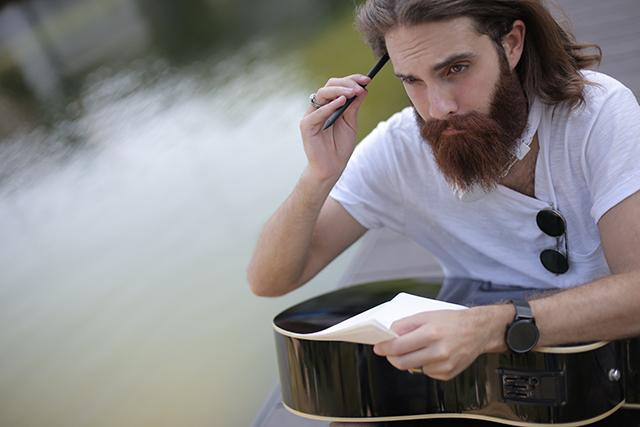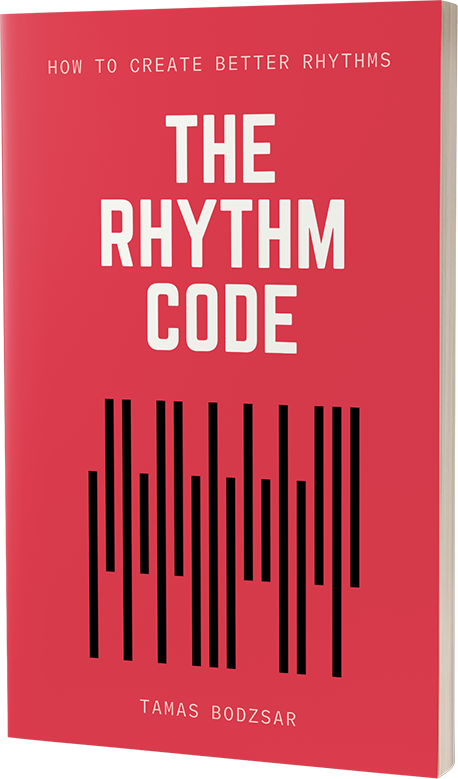
There are many different ways you can start to write a song, and every songwriter has their own process. Personally, I always follow an order which works best for me, and by the way, this is exactly the same order as John Legend writes his songs.
1. Chord progression
2. Arrangement (including a drumbeat, a bass groove, other rhythms)
3. Melody
4. Lyrics
But there are many other ways you can start a song, so let’s take a look at what other ways you can start to write a song.
1. Start with the chord progression
As I mentioned, this is my absolute favorite way to start a song. I believe that a chord progression by itself tells us a story, even without melody. And the chord progression needs to make sense on its own!
It needs to make sense in a way that it doesn’t sound weird. Because many times people write songs with weird chord progressions that don’t make sense, and the listener FEELS if something is not right.
You can decide if you want to use the same 3 or 4 chords throughout the entire song (which is very common nowadays), OR you can create different chord progressions for each part. (the verse, the chorus, the bridge, etc.)
How do you create a good chord progression? I analyzed more than 2000 songs to find the answer to that, you can learn it from our songwriting course.
What’s the next step?
When you have a chord progression, there are two possible ways to continue the song. The next step can be creating a melody for the chord progression, or you can create the music arrangement using the chord progression.
2. Start with the melody
Melody is probably the most important aspect of music in any genre. The melody is what the listeners will remember from your song, it’s what they will sing along with. The melody will be stuck in their ears for days, but only if you write a GOOD melody, of course.
Starting with the melody can be a good idea because you don’t need an instrument or a DAW, or any music to start to create melodies.
You don’t need to write the melody for the whole song, you can work only on small parts, for example, it’s best to start with the chorus melody since it’s the most important part of the song. It’s easier to work other parts of a song when you already have a great melody for the chorus.
It’s very important to record any melody ideas you have! You can use a voice recording app on your phone, or you can notate the melody notes on a paper the traditional way.
What’s the next step?
When you have a melody, even if it’s only for the chorus, you can start to find matching chords for it. Keep in mind that a melody can be harmonized in many different ways, with very different end results. Here is our previous post about how to harmonize a melody.
3. Start with the lyrics
You can start a song with the lyrics. The benefit of this is that you can find a topic for your lyrics, and that will give you some ideas about the MOOD and the TEMPO of the music.
For example, if the topic is sad, it’s better to write a song in a slower tempo, and start with a minor chord. But if the lyrics have a more positive message, you can write the song in an upper tempo, and use major chords. (You can learn about how to write a happy song from our previous blog post.)
What’s the next step?
When you have the lyrics, you can try to create a matching melody to the words. This can be done by using the natural rhythm of the words and syllables.
But since you already know if the song should be fast or slow, and if it’s happy or sad, you can continue with creating the music arrangement: a chord progression and a drumbeat at least.
4. Start with a groove
Depending on the genre of your music, you can start a song by creating a groove for the bass or the keyboard. If your genre is anything like funk, soul, blues, maybe Latin, you can create a unique groove for the bass or for the keyboard.
The groove is just a very rhythmic “melody” played by someone (or everyone) in the rhythm section (bass, guitar, keyboard, drums).
For example, listen to the song “Faith” by Stevie Wonder, and how they play the very same groove throughout the entire verse.
Another example is the song “Dark Necessities” by Red Hot Chili Peppers. Listen to the bass groove right after the intro, from 0:43.
If you know the song, you can immediately recognize the song just by hearing the bass groove.
You can create these kinds of unique grooves by using the Rhythm Code.
What’s the next step?
Let’s say you created a great bass groove. Now you need to decide, is this the groove for the verse or the chorus? Or maybe for both?
You can continue by figuring out a chord progression for that part of the song. To finish that part, all you need to do is copy the same rhythm, but adjust the notes of the groove to each chord. If you listen to the previous example, you can hear that the bass is just playing the very same rhythm on each chord, starting always on the root note of the chords.
5. Start with a guitar riff
Start writing a song by creating a guitar riff first. This is especially important if you write rock songs. For example, listen to the song “Black or White” by Michael Jackson. Or another example would be “Highway To Hell” by AC/DC.
While the first artist was not a typical rock artist, there is one thing in common between these two songs: they both start with a unique guitar riff. You can immediately recognize the song by listening only to the guitar riff at the beginning.
In our songwriting course, I show you the exact formula of how you can create a riff that is unique and catchy, so everyone will remember it.
These riffs are basically unique rhythms for the guitar chords.
What’s the next step?
If you wrote a nice guitar riff, you can decide if this riff will be in the verse or in the chorus, or in both? In the case of “Highway to Hell”, they only used the riff in the verses, and not in the chorus. On the other hand, in the case of “Black or White”, the guitar rhythm goes throughout almost the entire song – except for the bridge.
6. Start with a post-chorus
One of the best ways to come up with a chorus is by writing a post-chorus first. What is a post-chorus?
It’s the part the comes right after the chorus, and it has the same chord progression as the chorus.
It’s much easier to write a post-chorus, because:
– It’s much simpler than the chorus.
– It has fewer lyrics or no lyrics at all.
The post-chorus needs to be even catchier than the chorus, so you need to create a very catchy melody with no lyrics, or maybe say a few words at the end of the post-chorus. Those few words are usually the title of the song!
For example, listen to the song “Shape Of You” by Ed Sheeran. The post-chorus starts at 1:16, where they only sing “oh I oh I oh I oh I… I’m in love with your body”
What’s the next step?
When you created the post-chorus melody, you can try to find a matching chord progression. (Here is how to harmonize a melody.)
Once you have the post-chorus, it’s even easier to write the chorus, because the chorus will have the same chord progression, and you probably already have a few words in the post-chorus that you can also use at the end of the chorus, and even the song title.
Conclusion
1. You can start a song by writing a chord progression, and then you can continue with creating a matching melody, OR you can continue with arranging the music.
2. You can start with a melody, which doesn’t need any instrument because you can create melodies by singing your ideas for yourself. But don’t forget to record your ideas!
3. If you start with the lyrics, the topic will tell you the mood and the tempo of the music.
4. You can start a song by creating a unique groove first if it fits your genre.
5. Or you can create a guitar riff if you write rock songs.
6. Starting with writing the post-chorus is the best approach to write the best possible chorus.
The secret pattern behind successful songs
Get the eBook for $4.99

